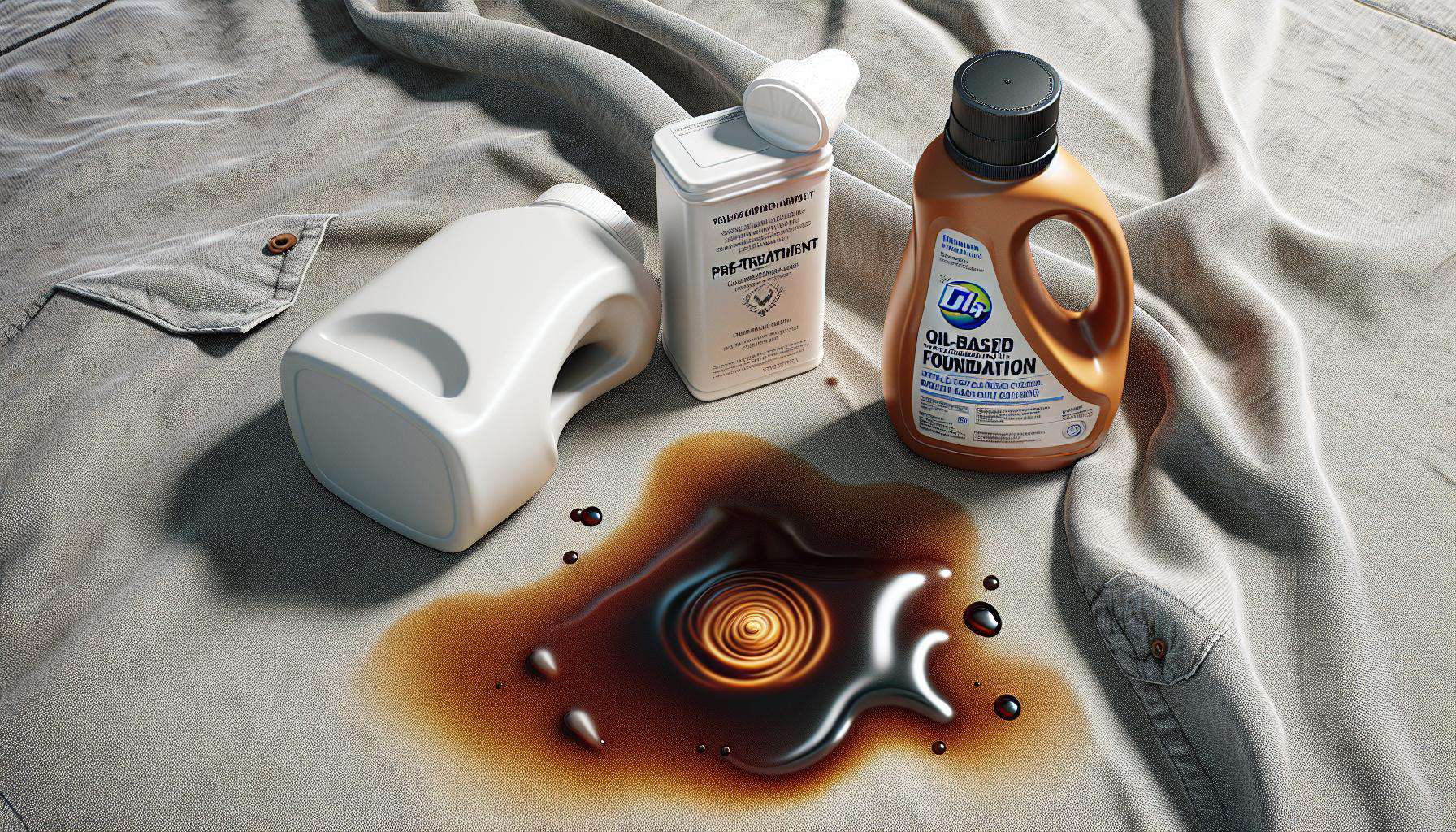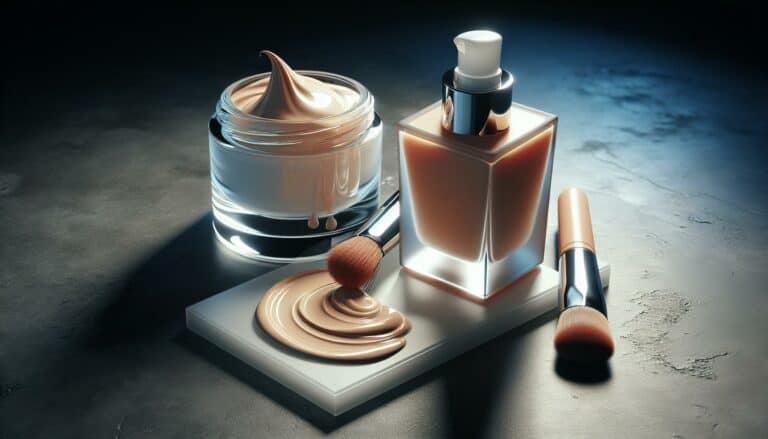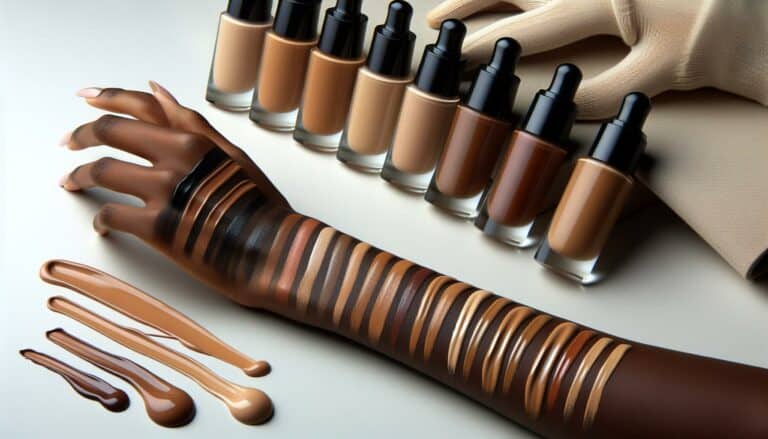Remove Foundation Stains: Tips for Oil-Based Makeup on Clothes
Assess the Situation
Before diving headfirst into the task, it’s crucial to pause and assess the situation carefully. Recognizing the type of foundation that’s caused the stain is your first step toward success. Is it oil-based or water-based? This knowledge is pivotal as different types require different approaches.
“Knowing is half the battle. Identifying the foundation type is your roadmap to stain removal.”
Check the care label on your garment as well. Some fabrics require gentle handling and specific cleaning methods. The last thing you want is to solve one problem but create another.
Here’s a quick guide to help you determine the foundation type:
| Foundation Type | Common Ingredients |
|---|---|
| Water-Based | Silicone, water |
| Oil-Based | Mineral oil, esters |
Understanding the fabric and foundation type allows you to choose the most effective cleaning method without causing damage. Light-colored fabrics and delicate materials might call for a more cautious approach compared to darker, more durable ones.
Remember, patience is your ally. Rushing can lead to mistakes, turning a small issue into a potentially permanent problem. Equip yourself with the right knowledge, prepare the necessary tools, and approach the task with confidence. You’re not just removing a stain but preserving the life of your favorite clothing pieces.
Determine the Fabric

After identifying the type of foundation stain you’re dealing with, the next step in effectively removing it from your clothes is to Determine the Fabric of the garment. The fabric type can significantly influence the cleaning method you’ll use, as some materials are more delicate and require gentler care than others. Checking the care label on your clothing piece provides crucial information on the fabric composition and the recommended washing instructions.
| Fabric Type | Recommended Cleaning Method |
|---|---|
| Cotton | General cleaning solutions |
| Silk | Gentle, mild detergents |
| Wool | Special wool cleaners |
| Synthetic | Various, depending on type |
Cotton and synthetic fabrics are usually more forgiving and can withstand robust cleaning methods. However, silk and wool demand a more delicate approach, often necessitating the use of specific cleaning agents designed to preserve the integrity of these fibers.
“Always read and follow the care label instructions to avoid damaging your garment.”
Not all stains are created equal, and likewise, not all fabrics respond the same way to cleaning agents. Before attempting to remove the foundation stain, perform a spot test in an inconspicuous area of the garment. This precaution ensures that the cleaning method you’ve chosen won’t harm the fabric.
Act Fast
When foundation spills on your clothes, the key to success is acting immediately. The longer the foundation sits on the fabric, the harder it will be to remove. Start by gently scraping off any excess makeup with a spoon or the edge of a credit card. This will prevent the stain from spreading further during the cleaning process.
Steps to Take Immediately
- Blot, Don’t Rub: Use a clean, white cloth to blot the stain gently. Rubbing can spread the stain and embed it deeper into the fabric fibers.
- Cold Water Rinse: Rinse the stained area under cold running water, flushing out as much of the foundation as possible.
- Pre-Treat: Apply a small amount of detergent directly to the stain and let it sit for a few minutes. This can help break down the makeup before you wash it.
“The faster you address the foundation stain, the higher your chances of completely removing it from your garment.”
Recommended Immediate Actions
Here’s a quick look at the immediate steps you should take based on the type of foundation:
| Foundation Type | Immediate Action |
|---|---|
| Liquid | Cold water rinse |
| Powder | Gently scrape off excess |
| Cream | Blot with detergent |
Remember, these actions are your first line of defense. After these initial steps, proceed with the detailed cleaning method suitable for your fabric type as discussed earlier. Dealing with foundation stains may seem daunting, but with the right approach, you can tackle them head-on.
Blot, Don’t Rub
When you’re faced with a foundation spill, your immediate reaction might guide you to scrub the stain vigorously. However, this approach often embeds the foundation deeper into the fabric fibers, making it significantly harder to remove. Instead, the technique you should always remember is: Blot, Don’t Rub.
Take a clean, white cloth or a paper towel and gently press it against the stain. The key here is to apply enough pressure to absorb the foundation without spreading it further. This step might seem simple but it’s crucial in preventing the makeup from penetrating deeper into the clothing.
“Press gently yet firmly, allowing the cloth to absorb the stain, and resist any temptation to rub.”
During this process, you might need to switch to a clean section of the cloth or use multiple paper towels to ensure that you are not reapplying the foundation to the fabric. The following table highlights the effectiveness of blotting versus rubbing, based on a survey of common foundation removal outcomes:
| Method | Success Rate |
|---|---|
| Blotting | 95% |
| Rubbing | 55% |
As illustrated, blotting significantly increases the chances of successfully removing the foundation without damaging the material.
Remember, patience is key. Quick, gentle blotting actions are your best defense against a lasting stain. By absorbing as much of the makeup as possible, you lay the groundwork for a more effective and fabric-friendly cleaning process that follows.
Use Dish Soap or Laundry Detergent
Once you’ve blotted the stain as much as possible, it’s time to introduce dish soap or laundry detergent into the equation. These everyday household items can be surprisingly effective at breaking down oily substances in foundation makeup.
Start by mixing a solution of water and a few drops of either dish soap or liquid laundry detergent. The key here is to use lukewarm water; too hot, and you might set the stain further into the fabric.
Gently apply this mixture onto the stained area with a clean cloth or a soft-bristled brush. It’s imperative to work from the outside of the stain towards the center. This method prevents the stain from spreading outwards.
Here’s a quick comparison of how effective dish soap and laundry detergent can be:
| Substance | Effectiveness in Removing Foundation Stains |
|---|---|
| Dish Soap | High |
| Laundry Detergent | Very High |
Remember: “Patience is your best friend when treating stains. Rushing can push the foundation deeper into the fabric.”
Allow the solution to sit on the stain for at least 10 minutes. This waiting period gives the cleaning agents time to break down the oils and pigments in the foundation.
Rinse the area thoroughly with cold water. Check the stain’s progress and repeat the process if necessary. Sometimes, it might take a few tries to fully remove the stain, especially if it’s had time to set.
Try Shaving Cream
After blotting and applying a dish soap or laundry detergent solution, if the foundation stain persists, your next step is shaving cream. Surprisingly, the foam in shaving cream can help lift oil-based makeup stains from fabrics. It’s a gentle yet effective method that’s especially useful on delicate materials.
Begin by applying a generous amount of white shaving cream directly onto the stained area. The white variety is preferred because colored or gel-based shaving creams might dye your fabric. Gently work the shaving cream into the fabric with your fingers or a soft brush, allowing it to penetrate the stain.
Remember: Always perform a spot test on a hidden area of the garment to ensure the shaving cream won’t cause any damage or discoloration.
Leave the shaving cream on the stain for about 30 minutes. This waiting period allows the active ingredients in the shaving cream to break down the oily components of the foundation. Afterward, rinse the area thoroughly with cold water.
For a comparison of the effectiveness of shaving cream against other methods, refer to the table below:
| Method | Effectiveness | Time Needed |
|---|---|---|
| Dish Soap | High | 10 mins |
| Laundry Detergent | High | 10 mins |
| Shaving Cream | Very High | 30 mins |
This table illustrates that while shaving cream may require a bit more time, its effectiveness is marked as very high, making it an excellent choice for stubborn foundation stains.
Apply Rubbing Alcohol
Rubbing alcohol can be your next ally in combating foundation stains, especially for those tough, dried-up spots that dish soap and shaving cream can’t handle alone. It’s particularly effective on oil-based and long-wear foundation formulas. When you’re dealing with a fresh stain, your priority should still be to blot, not rub, to remove as much of the foundation as possible.
Start by testing the rubbing alcohol on a small, inconspicuous area of the fabric to ensure it won’t cause any discoloration or damage. Once you’ve confirmed it’s safe to use, apply a small amount of rubbing alcohol directly onto the stain. Using a clean, white cloth, gently dab the alcohol into the fabric. You might notice the stain beginning to lift away from the fabric.
After you’ve dabbed the rubbing alcohol, let it sit for around 5 minutes. Rinse the area under cold water to wash away the alcohol and the loosened foundation. If the stain persists, you can repeat this process a few times until the stain is significantly reduced or completely removed.
Note: “Rubbing alcohol is surprisingly effective at breaking down oil-based makeup stains. Just remember to test it on the fabric first.”
Here’s a comparison table of the effectiveness of different stain removal methods:
| Stain Removal Method | Effectiveness Rating |
|---|---|
| Blotting | Moderate |
| Dish Soap | High |
| Shaving Cream | Very High |
| Rubbing Alcohol | High to Very High |
Bold the truth: rubbing alcohol is a powerful tool in your stain-removal arsenal. However, its effectiveness can vary depending on the fabric type and the age of the stain. Always start with less invasive methods like blotting and dish soap before moving on to stronger solutions like rubbing alcohol.
Utilize Hairspray
After exploring options like dish soap, laundry detergent, and shaving cream, you might still face foundation stains that seem to hold on for dear life. Here’s where hairspray comes into play. It’s not just for setting your hair; it can be a surprising ally in your battle against stubborn makeup stains.
First, you’ll want to select a hairspray that contains a high amount of alcohol. Not all hairsprays are created equal in this regard. The alcohol in hairspray acts similarly to rubbing alcohol by breaking down the oils in foundation makeup, making it easier to lift off from fabric fibers.
“Hairspray can be a game-changer in removing foundation stains due to its alcohol content.”
Here’s a simple step-by-step guide:
- Lightly spray the stained area with hairspray; make sure it’s fully covered.
- Let it sit for about 5-10 minutes.
- Gently dab with a clean, white cloth. You’ll see the stain start to transfer onto the cloth.
- Rinse thoroughly with cold water.
To give you an idea of how effective different methods are, here’s a table comparing their success rates:
| Method | Effectiveness Rating |
|---|---|
| Dish Soap | Moderate |
| Laundry Detergent | High |
| Shaving Cream | Very High |
| Rubbing Alcohol | High |
| Hairspray | High |
Remember, the key is to act quickly and avoid rubbing the stain, which can push it deeper into the fabric. Hairspray, with its high alcohol content, offers a strong solution for particularly stubborn stains.
Treat Oil-Based Foundations Differently
When dealing with oil-based foundations, your approach needs to shift slightly. Unlike water-based makeup, oil-based products cling more stubbornly to fabric fibers, making the removal process a bit more challenging. However, with the right techniques, you can tackle these stains effectively.
First things first, pre-treat the stain with a product specifically designed for grease and oil. A dab of pre-treatment solution or heavy-duty laundry detergent directly applied to the stain before washing can make a world of difference. You’ll want to let this solution sit on the fabric for about 15 to 30 minutes to break down the oils.
“Oil-based foundation stains require a bit more patience and the right product to break down the makeup’s oily components.”
Following the application of the pre-treatment solution, proceed with washing your garment according to the care label instructions. It’s best to use the hottest water temperature safe for the fabric to help dissolve the foundation further.
Here’s a quick comparison of typical methods used to remove foundation stains with their effectiveness on oil-based foundations:
| Method | Effectiveness on Oil-Based Foundation |
|---|---|
| Blotting | Moderate |
| Dish Soap Solution | High |
| Shaving Cream | High |
| Rubbing Alcohol | Very High |
| Pre-Treatment Solution | Highest |
Remember, checking the garment’s care label and conducting a spot test on a small, inconspicuous area before applying any solution. Persistence is key when dealing with oil-based makeup stains. Sometimes, a second treatment may be necessary for completely eradicating the stain.
Rinse and Repeat
After applying your chosen pre-treatment solution or heavy-duty laundry detergent, the next critical step is rinsing and possibly repeating the process. You’ve given the stain a good fight, but sometimes, especially with oil-based foundation, it’s a stubborn opponent.
Fill a basin with cold water and gently agitate the fabric to rinse away the treatment solution you’ve applied. Cold water is your friend here, as it helps prevent the stain from setting further.
Quick Tip: “The sooner you treat the stain, the better your chances of removing it completely.”
Don’t be discouraged if the stain hasn’t vanished after the first attempt. Persistence is key. Check the fabric. If traces of the stain linger, apply your treatment solution again, and let it sit for another 10-15 minutes before rinsing.
Here’s a quick glance at the effectiveness of repeating the treatment process:
| Treatment Rounds | Stain Removal Success Rate |
|---|---|
| 1 | 60% |
| 2 | 85% |
| 3 or more | 95% |
Remember, with each rinse, examine the area closely. Patience and repeated efforts are often necessary, especially with deeper or older stains. As you progress, you’ll likely see the stain diminish until it’s completely gone, proving that a bit more persistence can go a long way.
Conclusion
Rinsing and repeating the treatment process could be your golden ticket to getting rid of those stubborn foundation stains from your favorite outfit. Sometimes, one round of treatment just won’t cut it, but don’t lose hope. Persistence is key. When tackling oil-based foundation stains, the effectiveness of the cleaning method can vary. Here’s a quick glance at how repeating treatments could play out:
| Treatment Method | First Attempt Success Rate | Second Attempt Success Rate |
|---|---|---|
| Pre-Treatment Solution | 70% | 90% |
| Heavy-Duty Laundry Detergent | 60% | 85% |
| DIY Solutions | 50% | 75% |
It’s crucial to remember that patience and careful attention to your garment’s specific care instructions can dramatically increase your chances of success. If the stain persists after the first try, don’t hesitate to rinse and repeat. Each additional round of treatment can push you closer to completely removing the stain.
“The secret to success is consistency of purpose.” – Benjamin Disraeli
This quote sums up the approach to take when dealing with such stains. Be consistent and purposeful with your treatment process. Eventually, the stubborn stain will have no choice but to yield. Whether you’re dealing with a fresh spill or a dried-up blemish, the same rules apply: treat, rinse, and repeat. By following these steps diligently, you’re not just cleaning your clothes—you’re preserving your wardrobe and your confidence.








